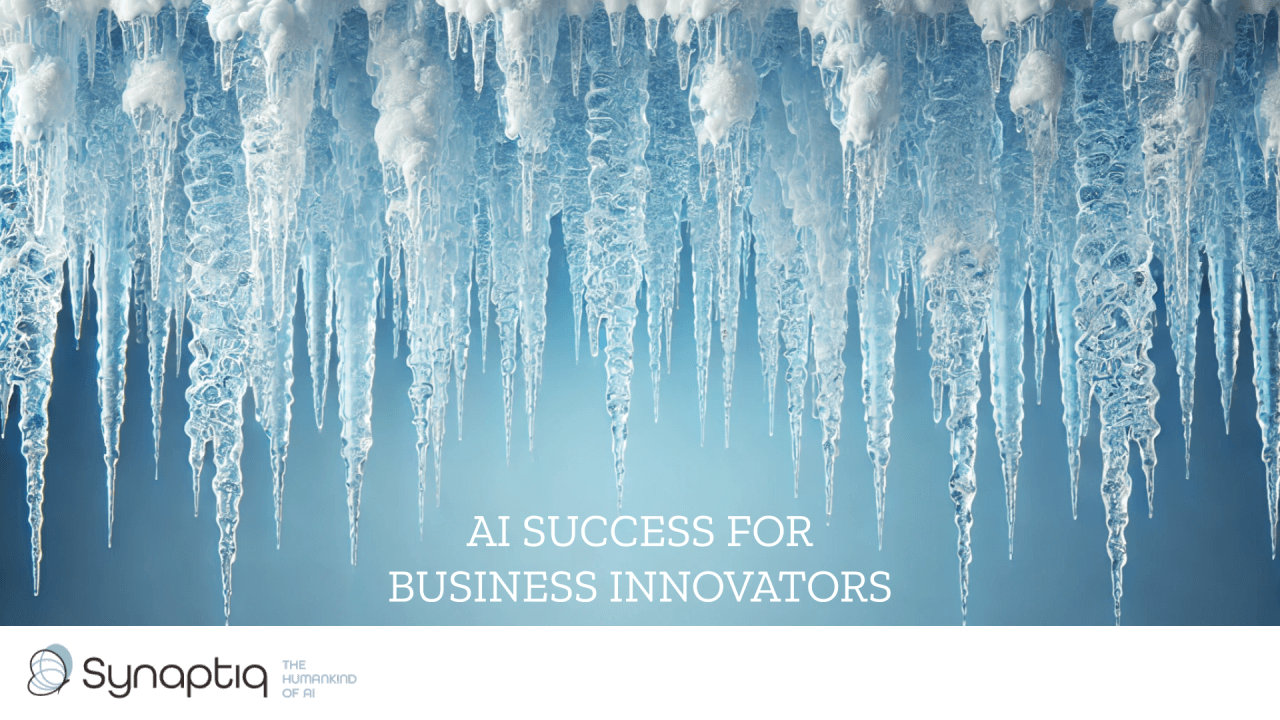Measuring What Matters: AI Adoption
You’ve invested in AI. The models are live. The tools are ready. But adoption is lagging. Why?Because AI adoption isn’t...
|
CONSTRUCTION & REAL ESTATE
|
 |
|
Discover how crafting a robust AI data strategy identifies high-value opportunities. Learn how Ryan Companies used AI to enhance efficiency and innovation.
|
| Read the Case Study ⇢ |
|
LEGAL SERVICES
|
 |
|
Discover how a global law firm uses intelligent automation to enhance client services. Learn how AI improves efficiency, document processing, and client satisfaction.
|
| Read the Case Study ⇢ |
|
HEALTHCARE
|
 |
|
A startup in digital health trained a risk model to open up a robust, precise, and scalable processing pipeline so providers could move faster, and patients could move with confidence after spinal surgery.
|
| Read the Case Study ⇢ |
|
LEGAL SERVICES
|
 |
|
Learn how Synaptiq helped a law firm cut down on administrative hours during a document migration project.
|
| Read the Case Study ⇢ |
|
GOVERNMENT/LEGAL SERVICES
|
 |
|
Learn how Synaptiq helped a government law firm build an AI product to streamline client experiences.
|
| Read the Case Study ⇢ |
 |
|
Mushrooms, Goats, and Machine Learning: What do they all have in common? You may never know unless you get started exploring the fundamentals of Machine Learning with Dr. Tim Oates, Synaptiq's Chief Data Scientist. You can read and visualize his new book in Python, tinker with inputs, and practice machine learning techniques for free. |
| Start Chapter 1 Now ⇢ |

By far the biggest lesson I’ve learned since getting involved in AI is that quality data is the limited resource critical for AI success.
One of the main reasons why large language models like ChatGPT are so successful is that they were trained on massive amounts of data (e.g., the internet) and improved with human feedback.
That said, one of the not so obvious things I learned shortly after starting Synaptiq is that oftentimes you will hit a “cold start problem”.
Let’s take the example of building an AI recommendation engine for an e-commerce site. There are typically two approaches:

In the first approach, so long as you have a past purchase history and a well-defined product catalog, an AI model can start making reasonable recommendations. In the second model, so long as you have a profile and there are others with similar profiles that have purchased products in the past, recommendations are possible.
But, what if you haven’t purchased products in the past, you don’t have a profile yet, or there aren’t others with similar profiles that have purchased products?
This is a classic cold start problem, and it’s a common challenge across a wide range of AI applications like:
There are basically three creative options to overcome a cold start problem:
Data sourcing
If you don’t have the data you need on hand, there are a handful of options with varying levels of effort and cost.
To dive deeper into this topic read How Much Data Do We Need blog written by my cofounder, Dr. Tim Oates.
Product design & user experience
When you have a cold start problem, it’s important to think carefully about your product’s user experience. There are smart ways to design an experience that help you overcome the cold start problem while engaging your early adopters.
Here are few suggestions:
The key here is to invest in the upfront product design for a cold start situation and iteratively improve the experience, or you may never get out of the “chicken and egg problem.
Go-To-Market
Finally, think carefully about your rollout strategy, pricing strategy, and business case expectations. For instance, it may be best to start with a small segment of users in a pilot before generating awareness. Likewise, your pricing may need to be low until your AI models start generating value. And, whatever you do, don’t overset expectations on any sort of ROI dates until your product has spent time in users’ hands.
For those of you that are in sensitive information or knowledge worker organizations (e.g., healthcare, legal, finances, professional services, etc.), it’s also best practice to pilot your AI models internally first.
Real life examples
We have run into many cold start problems over the last 10 years. But there are two that stand out and are easy to explain.
The first was a project we worked on as a subcontractor for the federal government early in our journey. Back then, the federal government employed a lot of contractors to build cloud applications and struggled to manage all the costs for cloud resources. The big cloud providers didn’t have any automated tools to help the government optimize its cloud resources.
We built a system that monitored cloud resource consumption and optimized it against its expected quality of service. That meant we needed a lot of cloud consumption data to prove we had a viable approach which, unfortunately, the government wasn’t going to give us direct access to. So, we had a cold start problem. To overcome this challenge, we generated simulated data in our isolated environment, tuned the model until it met expectations, then gave it to the government to deploy in their secure environment.
You can read more about it in our published research paper, Automated Cloud Provisioning on AWS using Deep Reinforcement Learning.
Shortly after, we worked for a company that sells custom curriculums of training courses to businesses. When we met them, they had realized that their sales and customer success team wasn't going to scale effectively if every sale required manual human curation. So we built an AI recommender for them fueled by their historical data.
Everything was going great until we learned that they were selling into a wide range of customers with diverse profiles. There was a high likelihood that a prospective customer wouldn’t be similar to any active customers. In this cold start situation, we worked with the client to purchase company profile data so that our AI model would work if the prospective customer’s profile wasn’t already in the system.
This company also rolled out our model as a sales and customer success support tool initially, then expanded it into an active customer recommendation system.
Conclusion
A cold start problem is a common hurdle when launching AI solutions, especially for machine learning models that rely on robust datasets to function effectively. Without adequate initial data, these systems often struggle with accuracy and performance issues.
Fortunately, a multifaceted approach can help organizations navigate this challenge. By tapping into alternative data sources—whether public repositories, adjacent domain data, or synthetically generated information—companies can build a foundational dataset. Thoughtful product design that incorporates strategic data collection mechanisms and expert human oversight further strengthens the solution. Creating intuitive user experiences that naturally encourage data sharing also accelerates the learning curve.
From a strategic perspective, targeting early adopters and focusing on applications that deliver value even with limited data helps establish momentum. As users engage with the system, the expanding dataset fuels continuous improvement in the AI's capabilities.
With creativity and pragmatism, businesses can successfully implement AI solutions that evolve and mature alongside their growing data resources, ultimately delivering increasingly powerful results over time.

Synaptiq is an AI and data science consultancy based in Portland, Oregon. We collaborate with our clients to develop human-centered products and solutions. We uphold a strong commitment to ethics and innovation.
Contact us if you have a problem to solve, a process to refine, or a question to ask.
You can learn more about our story through our past projects, blog, or podcast.
You’ve invested in AI. The models are live. The tools are ready. But adoption is lagging. Why?Because AI adoption isn’t...
December 5, 2025
For three years, AI went from a talking point to a reckless boardroom obsession. Leaders bypassed caution,...
November 25, 2025
You launched the AI model. The dashboards went live. And… nothing changed. The same meetings.The same decisions.The...
November 18, 2025